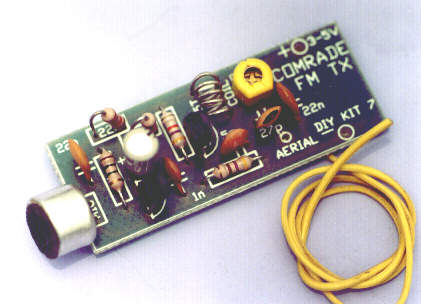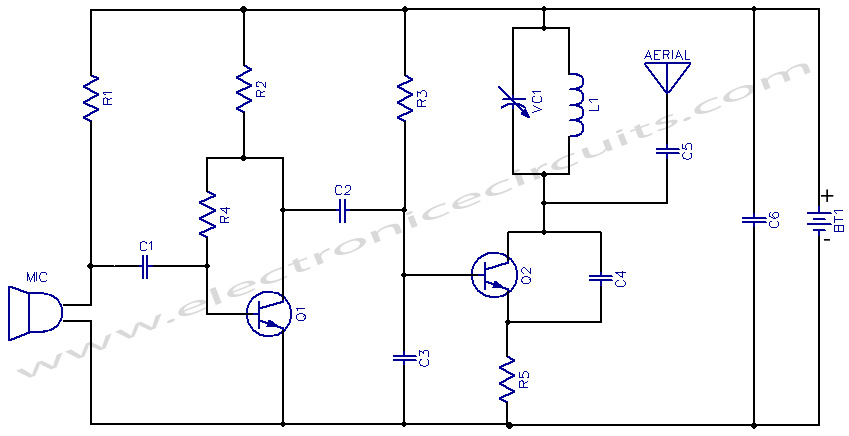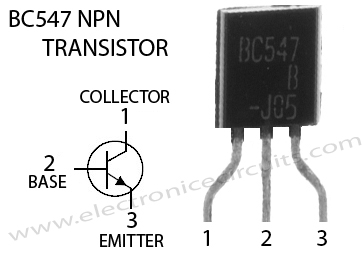
3V FM Transmitter Circuit
This project provides the schematic and the parts list needed to construct a 3V FM Transmitter. This FM transmitter is about the simplest and most basic transmitter to build and have a useful transmitting range. It is surprisingly powerful despite its small component count and 3V operating voltage. It will easily penetrate over three floors of an apartment building and go over 300 meters in the open air.
It may be tuned anywhere in the FM band. Or it may be tuned outside the commercial M band for greater privacy. (Of course this means you must modify your FM radio to be able to receive the transmission or have a broad-band FM receiver.) The output power of this FM transmitter is below the legal limits of many countries (eg, USA and Australia). However, some countries may ban ALL wireless transmissions without a licence. It is the responsibility of the constructor to check the legal requirements for the operation of this kit and to obey them.

| PARTS LIST | |
| R1 | 22KΩ |
| R2 | 10KΩ |
| R3 | 47KΩ |
| R4 | 1MΩ |
| R5 | 470Ω |
| C1 | 22n (223) ceramic |
| C2 | 100n monoblock |
| C3 | 1n (102) ceramic |
| C4 | 5.6p ceramic |
| C5 | 27p ceramic |
| C6 | 22n (223) |
| VC1 | Trim Cap 6-45 pF |
| Q1 | BC547 |
| Q1 | BC547 |
| L1 | 5 turn coil |
| MIC | Electret microphone |
| AERIAL | Aerial Wire 165cm |
| BT1 | 3-5V (2 AA Battery holder) |
FM Transmitter Circuit Description
The circuit is basically a radio frequency (RF) oscillator that operates around 100 MHz. Audio picked up and amplified by the electret microphone is fed into the audio amplifier stage built around the first transistor. Output from the collector is fed into the base of the second transistor where it modulates the resonant frequency of the tank circuit (the 5 turn coil and the trimcap) by varying the junction capacitance of the transistor. Junction capacitance is a function of the potential difference applied to the base of the transistor. The tank circuit is connected in a Colpitts oscillator circuit.
The electret microphone: an electret is a permanently charged dielectric. It is made by heating a ceramic material, placing it in a magnetic field then allowing it to cool while still in the magnetic field. It is the electrostatic equivalent of a permanent magnet. In the electret microphone a slice of this material is used as part of the dielectric of a capacitor in which the diaphram of the microphone formsone plate. Sound pressure moves one of its plates. The movement of the plate changes the capacitance. The electret capacitor is connected to an FET amplifier. These microphones are small, have excellent sensitivity, a wide frequency response and a very low cost.
First amplification stage: this is a standard self-biasing common emitter amplifier. The 22nF capacitor isolates the microphone from the base voltage of the transistor and only allows alternating current (AC) signals to pass.
The tank (LC) circuit: every FM transmitter needs an oscillator to generate the radio Frequency (RF) carrier waves. The tank (LC) circuit, the BC547 and the feedback 5pF capacitor are the oscillator in the Cadre. An input signal is not needed to sustain the oscillation. The feedback signal makes the base-emitter current of the transistor vary at the resonant frequency. This causes the emitter-collector current to vary at the same frequency. This signal fed to the aerial and radiated as radio waves. The 27pF coupling capacitor on the aerial is to minimise the effect of the aerial capacitance on the LC circuit. The name ‘tank’ circuit comes from the ability of the LC circuit to store energy for oscillations. In a pure LC circuit (one with no resistance) energy cannot be lost. (In an AC network only the resistive elements will dissipate electrical energy. The purely reactive elements, the C and the L simply store energy to be returned to the system later.) Note that the tank circuit does not oscillate just by having a DC potential put across it. Positive feedback must be provided. (Look up Hartley and Colpitts oscillators in a reference book for more details.)

ASSEMBLY INSTRUCTION
Components may be added to the PCB in any order. Note that the electret microphone should be inserted with the pin connected to the metal case connected to the negative rail (that is, to the ground or zero voltage side of the circuit). The coil should be about 3mm in diameter and 5 turns. The wire is tinned copper wire, 0.61 mm in diameter. After the coil in soldered into place spread the coils apart about 0.5 to 1mm so that they are not touching. (The spacing in not critical since tuning of the Tx will be done by the trim capacitor. It is quite possible, but not as convenient, to use a fixed value capacitor in place of the trimcapacitor – say 47pF – and to vary the Tx frequency by simply adjusting the spacing of the coils. That is by varying L of the LC circuit rather than C.) Adding and removing the batteries acts as a switch.Connect a half or quarter wavelength antenna (length of wire) to the aerial point. At an FM frequency of 100 MHz these lengths are 150 cm and 75 cm respectively.
CIRCUIT CALIBRATION
Place the transmitter about 10 feet from a FM radio. Set the radio to somewhere about 89 – 90 MHz. Walk back to the FM transmitter and turn it on. Spread the winding of the coil apart by approximately 1mm from each other. No coil winding should be touching another winding. Use a small screw driver to tune the trim cap. Remove the screwdriver from the trim screw after every adjustment so the LC circuit is not affected by stray capicitance. Or use a plastic screwdriver. If you have difficulty finding the transmitting frequency then have a second person tune up and down the FM dial after every adjustment. One full turn of the trim cap will cover its full range of capacitance from 6pF to 45pF. The normal FM band tunes in over about one tenth of the full range of the tuning cap.
So it is best to adjust it in steps of 5 to 10 degrees at each turn. So tuning takes a little patience but is not difficult. The reason that there must be at least 10 ft. separation between the radio and the FM transmitter is that the FM transmitter emits harmonics; it does not only emit on one frequency but on several different frequencies close to each other. You should have little difficulty in finding the Tx frequency when you follow this procedure.
LEARNING EXPERIENCE
It should already be clear from the above circuit description that there is a surprising amount of electronics which may be learnt from this deceptively simple kit. Here is a list of some advanced topics in electronics which can be demonstrated or have their beginnings in this project:
Class C amplifiers; FM transmission; VHF antennas; positive and negative feedback; stray capacitance; crystal-locked oscillators; signal attenuation The simple halfwave antenna used in the project is not the most efficient. Greater efficiency may be gained by connecting a dipole antenna using 50 ohm coaxial cable. Connect one lead to the Antenna point and the other to the earth line.
You may experiment using 6V or 9V with the circuit to see how this increases the range of the transmitter. The sensitivity may be increased by lowering the 22K resistor to 10K. Try it and see. Note that this FM transmitter is not suitable for use on your body, for example, in your pocket. This is because it is affected by external capacitance and the transmitting frequency drifts depending how close you are to it. Stray capacitance is automatically incorporated into the capacitance of the tank circuit which will shift the transmitting frequency.
Please send your ideas, which are very important for our success…
needed here
5dFRIO I want to say – thank you for this!
Hello from Russia)
Dear Author http://www.electronicecircuits.com !
What charming message
Hello,
I wanna thaks for the good works, I want a transmitter circuit lower than 20cm range.
Thanks.
HLQVOH I am always excited to visit this blog in the evenings.Please churning hold the contents. It is very entertaining.
thanks for new
Hi to avoid antenna damping the oscillator shift capacitor C5 to a tap at 1 turn from the supply end of the tank coil L1 (I have used a 75cms length whip antenna. For 3Volt operation reduce Condencer mic bias resistance to 3.3K. C6 is a must use 47uF with 0.1 Ceramic disc in parallel. A good circuit. Nice quality.
i need to shematic of negative ion generator . would u help me?
what is C6
C6 = 22nF (223)
thanks
i try this circuit but it its range is small&poor stability.u can just add a extra amplifier stage to improve the range& stability.any way thanks for the circuit,
HI!, im an electronics engineering student, this circuit is so good and it can also work with a 9 volt battery, try it…. and enjoy…… is there a russian gurl over there???
thanx
i am very enthusiastic to make such use full circuit .
please send me new updates of the electronics world.
What are your thoughts on using a 2N3904 NPN transistors? Not enough gain?
i am not having trim cap what to do
good
gooddddddddddddddddddddddddddddddddddddddddd!!!!!!!!!!!!!!!!!!!!!!!!!!!!!!!!!!!!!!!!!!!!!!!!!!!!!!!!!!
really gonna do this how much it is efficent …
Dear sir,
If i would like the FM TX operate in 40.xxMhz, which parts in the circuit should i focus?
Please kindly share me the detail as i’m new to RF design
does it works…..????
why is the aerial so long like 165 cm its very long??
great circuit but i need detail of C6
thnx alot man…..dis worked really well….:D
Sir
Send me this 3v Fm transmitter coil number 14.18.22. 28?
Thanks
Coil Wire Number
is there 165cm wire need
a master piece…………….. Thanks….. can i modify it to a gsm cell phone jammer?????? jus by changing the no. of turns of inductor and varying the value of vc1????
plz telle me how to test
bc547 with multimiter
Like!
i am use this for my guitar
Having problem in tuning……………….. what can i Do?
please send me transmiter fm circuit hi power ane contact me thanks
how to make the frequency at 80MHz?? what is needed to be changed??
can I use the transmitter circuit for the 76mhz operation?How it is done using the circuit?
is this circuit in running condition
???
this website is very good for us
How to make 5 turn coil
hello tank you
I connect them all together but nothing happens.what is prrobably wrong ?
please give me a 6 v vhf or uhf transmeter for vedio transfer
what is the transmitters operating frequency?how can i increase the operating range?thanks
Can I use C945 inplace of BC 547
did you tested it
am in line of building it
thanks i love technology
any body who have ever tested this circuit i need it
is super,it work perfectly